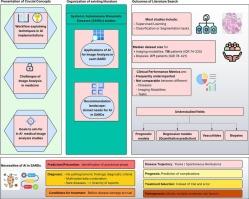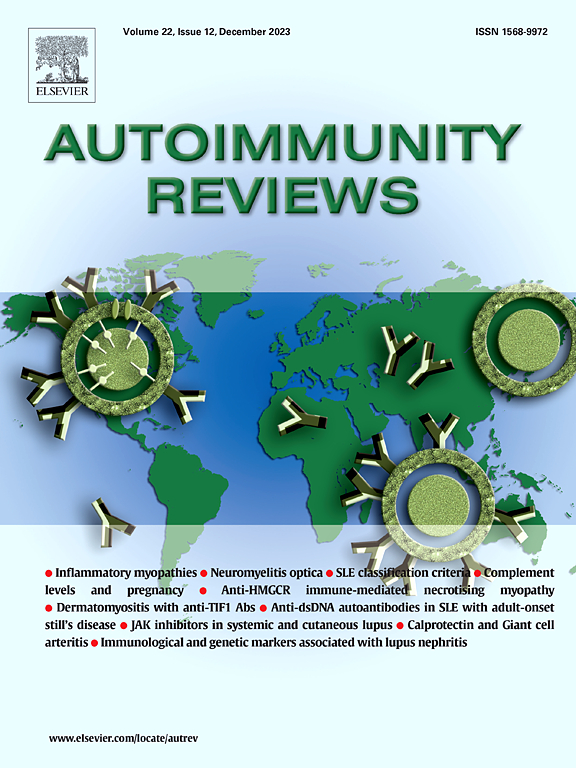人工智能在系统性自身免疫性风湿病的活检和成像模式:一个有益的叙述回顾
IF 8.3
1区 医学
Q1 IMMUNOLOGY
引用次数: 0
摘要
目的整理有关人工智能(AI)在系统性自身免疫性风湿性疾病(SARDs)患者活检和成像模式中的应用的现有文献,使读者熟悉最常见的概念。首先,我们提出了一个工作流,总结了在SARDs中人工智能实施的活检技术和成像模式。接下来,我们描述了医学图像分析的具体挑战。随后,我们描述了该领域人工智能研究的目标,以及在sard中满足这些目标的先决条件。最后,在回顾了现有文献后,我们介绍了人工智能在每个SARD中的图像分析应用。因此,我们分析了每个SARD的1-2项研究,并提到了从中得到的关键信息和教训。最后,我们创建了一个推荐场景,确定每个SARD中AI应用程序未满足的需求。绝大多数研究将监督学习用于图像分类或分割,很少用于回归。数据集大小中位数为影像学研究116例患者和活检研究271例患者,而每项研究的图像数量差异很大。多个性能指标的报告经常被忽略。结论采用人工智能进行SARD图像分析最终需要具有多模态和充分多样化数据的大型数据集,以有效捕获SARD的异质性。在风湿病学领域,受主观性和观察者间可变性的困扰,有关数据质量、监管当局以及所提出问题的特异性和临床影响的问题将决定临床采用人工智能辅助医疗所需的时间。本文章由计算机程序翻译,如有差异,请以英文原文为准。

Artificial intelligence for biopsies and imaging modalities in systemic autoimmune rheumatic diseases: An instructive narrative review
Purpose
To organize the existing literature regarding applications of artificial intelligence (AI) in biopsies and imaging modalities of patients with systemic autoimmune rheumatic diseases (SARDs) and to familiarize readers with the most commonly occurring concepts.
Results
Firstly, we present a workflow that summarizes techniques implemented in AI for biopsies and imaging modalities in SARDs. Next, we describe challenges specific to image analysis for medicine. Subsequently, we describe the goals for an AI study in this field, and the prerequisites to meet them in SARDs. Finally, after reviewing the existing literature, we present the applications of AI for image analysis in each SARD. Accordingly, we analyze 1–2 studies from each SARD and mention key messages and lessons derived from them. Lastly, we create a recommendation landscape identifying unmet needs for AI applications in each SARD. The vast majority of studies employ supervised learning for image classification or segmentation, and rarely for regression. The median dataset size was 116 patients for imaging studies and 271 patients for biopsies studies, while the number of images per study varied greatly. Reporting of multiple performance metrics was frequently neglected.
Conclusions
Employing AI for SARD image analysis ultimately demands large datasets with multimodal and adequately diverse data to effectively capture the heterogeneity of SARDs. In the field of rheumatology, plagued by subjectivity and interobserver variability, issues regarding data quality, regulatory authorities and the specificity and clinical impact of questions posed will define the time needed for clinical adoption of AI-assisted medical care.
求助全文
通过发布文献求助,成功后即可免费获取论文全文。
去求助
来源期刊

Autoimmunity reviews
医学-免疫学
CiteScore
24.70
自引率
4.40%
发文量
164
审稿时长
21 days
期刊介绍:
Autoimmunity Reviews is a publication that features up-to-date, structured reviews on various topics in the field of autoimmunity. These reviews are written by renowned experts and include demonstrative illustrations and tables. Each article will have a clear "take-home" message for readers.
The selection of articles is primarily done by the Editors-in-Chief, based on recommendations from the international Editorial Board. The topics covered in the articles span all areas of autoimmunology, aiming to bridge the gap between basic and clinical sciences.
In terms of content, the contributions in basic sciences delve into the pathophysiology and mechanisms of autoimmune disorders, as well as genomics and proteomics. On the other hand, clinical contributions focus on diseases related to autoimmunity, novel therapies, and clinical associations.
Autoimmunity Reviews is internationally recognized, and its articles are indexed and abstracted in prestigious databases such as PubMed/Medline, Science Citation Index Expanded, Biosciences Information Services, and Chemical Abstracts.
 求助内容:
求助内容: 应助结果提醒方式:
应助结果提醒方式:


